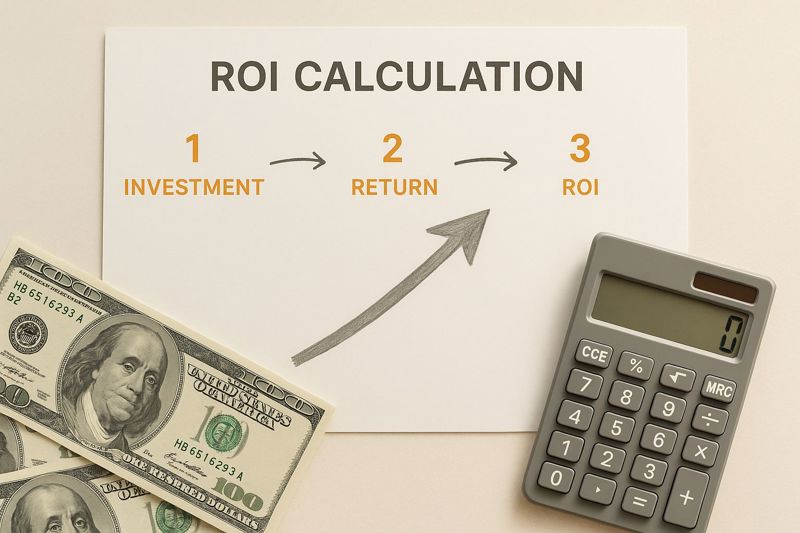A social media ROI calculator is your best friend for turning abstract engagement data into a clear financial story. It helps you measure the real-world success of your campaigns by tracking what actually matters—conversions, costs, and customer value—instead of just chasing vanity metrics like likes and shares.
Moving Beyond Likes and Shares

It’s easy to get caught up in the excitement of a viral post. High engagement feels like a win, but let's be honest: likes, comments, and shares don't pay the bills. This is where a lot of social strategies fall flat—they mistake online buzz for tangible business results.
The real challenge is proving your efforts are generating actual value. Without a clear connection to revenue, good luck justifying your budget, optimizing campaigns, or showing your department's worth to stakeholders who live and breathe financial reports. A social media ROI calculator bridges that divide perfectly.
Translating Metrics into Money
This kind of tool forces you to look past the surface-level fluff and focus on what truly drives the business forward. Instead of just counting likes, you start asking much better questions:
- How many of those people who engaged actually clicked through to our website?
- Of those visitors, how many signed up for our newsletter or downloaded a lead magnet?
- What was the total revenue generated from sales we can directly trace back to this specific campaign?
This shift in perspective is what separates a social media hobby from a professional marketing operation. A good ROI calculator is essential for tracking conversions, costs, and engagement across all your platforms, turning abstract data into financial insights you can actually use.
The ultimate goal here is to connect every dollar you spend on social media to a measurable return. When you can confidently say, "We invested $500 in this campaign and generated $2,500 in sales," you've won the argument.
By consistently applying this framework, you transform your social media activities from a fuzzy cost center into a predictable revenue driver. This approach aligns perfectly with the core principles of data-driven decision-making, which is a cornerstone of modern social media marketing best practices.
What to Track for an Accurate Calculation

Before you can even think about using a social media ROI calculator, you need to gather the right ingredients. Any calculation is only as good as the data you feed it, and that data falls into two main buckets: your total investments and your measurable returns.
It’s about looking beyond the obvious numbers. Getting this right means digging a little deeper than you might expect.
Uncovering Your Total Social Media Investment
Your investment isn't just your monthly ad spend. Far from it. To get a true picture of your costs, you have to account for every single thing that contributes to your social media presence. These are the often-missed expenses that can seriously skew your final ROI.
Think of it as the complete financial commitment to your social strategy. A comprehensive list grounds your calculation in reality.
Here's what you need to start gathering:
- Ad Spend: This is the easy one. It's the total amount you've paid for promoted posts, ads, and campaigns across all platforms.
- Content Creation Costs: Did you hire a photographer, videographer, or graphic designer? Don't forget to include freelance fees, new equipment, or stock photo subscriptions.
- Software and Tools: Add up the monthly or annual fees for your scheduling tools, analytics platforms, or any content creation software you rely on.
- Prorated Team Salaries: This is a big one people miss. Calculate the hourly wage of anyone involved in social media and multiply it by the hours they spend on those tasks each month.
Defining and Valuing Your Returns
Now for the other side of the equation: your returns. This is where you connect what happens on social media directly to your bottom line. The whole game here is to assign a concrete monetary value to the actions your audience takes.
The most important metric is conversion tracking, where actions like a lead capture or a direct purchase are attributed back to a specific social campaign. This is exactly why using dedicated landing pages is so critical—it allows you to reliably connect a social click to actual revenue.
Don’t just stop at the first sale. You need to factor in Customer Lifetime Value (CLV). This gives you a much more accurate, long-term view of the real return from customers you've acquired through social media.
Tracking conversions properly requires a bit of setup. A good Social Media Analytics Dashboard Guide can be a lifesaver for organizing all this performance data so you can actually make sense of it.
But it’s not just about direct sales. You also need to assign value to non-purchase conversions, like leads. You can learn more about how to track these actions by exploring different social media engagement metrics.
Building Your Own ROI Calculator in a Spreadsheet
You don't need fancy, expensive software to figure out your social media ROI. Honestly, a simple spreadsheet is one of the most powerful tools you can have. Building your own gives you complete control and a crystal-clear understanding of where your money is going and what it’s bringing back.
Let's walk through how to build one from scratch.
First things first, open up a new Google Sheet or Excel file. The whole point is to create a simple structure that separates what you spend from what you earn, letting the spreadsheet do all the math for you.
This visual breaks down the basic flow—you put in your costs and your returns, and it spits out the final ROI. Simple as that.

Now, let's turn that concept into a working calculator.
What Metrics Do You Need?
Before you start plugging in numbers, you need to know what numbers to track. A good calculator needs clear inputs for both your investments (the money going out) and your returns (the money coming in).
Here’s a quick breakdown of the essential metrics you'll want to include.
Essential Metrics for Your ROI Calculator
| Metric Category | Specific Metric | Example |
|---|---|---|
| Investments | Ad Spend | Money spent on Facebook Ads, TikTok campaigns, etc. |
| Investments | Team Hours | The cost of your team's time spent on social media. |
| Investments | Software/Tools | Subscription fees for schedulers, analytics, etc. |
| Investments | Content Creation | Costs for photographers, videographers, or designers. |
| Returns | Direct Sales | Revenue from sales made directly through social channels. |
| Returns | Lead Value | The estimated value of leads generated from social media. |
| Returns | Referral Traffic Value | Value of website traffic driven from social platforms. |
Getting these inputs right is the key to an accurate calculation. If you miss a cost or forget a revenue stream, your final ROI number won't tell the whole story.
Setting Up the Spreadsheet
Now, let's structure your sheet. The key to making this work is organization. You don't want to be scrambling to find numbers later.
Create a few simple columns to log everything:
- Investment Category: This is where you'll list each type of cost (e.g., Ad Spend, Software, Team Hours).
- Investment Amount ($): The dollar amount for each investment.
- Return Category: The source of your revenue (e.g., Product Sales, Leads Generated).
- Return Amount ($): The actual revenue you brought in from each source.
This layout gives you a clean, itemized view of all the money flowing in and out. By breaking it down like this, you’ll avoid the common trap of underestimating your total investment.
My go-to tip: Create a new tab for each month or for every major campaign. It keeps everything tidy and makes it incredibly easy to compare performance over time without one massive, cluttered sheet.
Plugging in the Formula
Alright, here comes the fun part. Find an empty cell where you want your final ROI percentage to live. This is where you'll enter a simple formula to do the heavy lifting.
The classic formula for ROI is (Net Profit / Total Investment) x 100.
In spreadsheet language, that looks like this: =(SUM(D:D) - SUM(B:B)) / SUM(B:B)
Let's break that down:
SUM(D:D)adds up everything in your Return Amount column.SUM(B:B)adds up everything in your Investment Amount column.
The last step is to format that cell as a percentage. Now, whenever you add or change a number in your investment or return columns, your ROI will update instantly. You get a real-time pulse on how your campaigns are performing.
Making Sense of Your Social Media ROI
So, you’ve plugged your numbers into a social media ROI calculator, and it spit out a percentage. Great! But what does that number actually mean? A percentage on a spreadsheet is just data; turning it into a smart, strategic action is where the real magic happens.
That ROI figure is a direct pulse check on your campaign's financial health. It’s telling you, in no uncertain terms, whether your efforts are a profitable investment or just a resource drain. Think of it less like a pass/fail grade and more like a diagnostic tool that points you toward better decisions.
What Is a Good Social Media ROI?
Here’s the thing: a "good" ROI isn't a one-size-fits-all number. It can vary wildly depending on your industry, the specific goal of your campaign, and your own profit margins.
That said, some broad benchmarks can give you a helpful starting point. Many successful social media campaigns often see returns of 2 to 3 times their initial investment. Put simply, for every dollar you spend, you should aim to bring in $2 to $3 in revenue. It's always a good idea to explore industry benchmarks to see how your results stack up.
If your ROI is high, that's a crystal-clear signal to double down. Pinpoint which platforms, content formats, or ad creatives are driving those stellar results and start allocating more of your budget there. It’s the ultimate validation that your strategy is on the right track.
A positive ROI, no matter how small, is a win. It proves that your social media efforts are contributing directly to the bottom line, moving them from a 'cost center' to a 'revenue generator' in the eyes of any stakeholder.
On the flip side, a low or even negative ROI isn't a failure—it's an opportunity to optimize. This is your chance to roll up your sleeves and investigate what isn’t clicking.
Some common culprits for a poor ROI include:
- High Ad Costs: Is your cost-per-click or cost-per-acquisition just too high for your product’s price point?
- Poor Conversion Rates: Are you getting plenty of clicks but seeing people drop off on your landing page?
- Ineffective Targeting: Is your message fantastic, but you're showing it to the wrong audience?
Answering these questions is fundamental to understanding your campaign performance. To dig even deeper, it helps to understand the broader principles of how to measure marketing ROI across all your channels, not just social media.
The insights you get from your social media ROI are a crucial piece of this bigger puzzle. They help you set more realistic benchmarks for future campaigns and continuously refine your approach. For more on this, check out our complete guide on how to measure marketing campaign success.
Common Mistakes When Calculating Social Media ROI
Nailing your social media ROI calculation can feel like a superpower, but a few common missteps can send you wildly off course. Getting a number you can actually trust from your social media ROI calculator means dodging the pitfalls that trip up even seasoned marketers.
One of the biggest blunders is undercounting your investment. It’s tempting to just add up your ad spend and call it a day, but that’s not the whole story—not even close.
Are you factoring in the prorated salaries of your team members who run the accounts, create the content, and chat with your community? What about the monthly subscriptions for your scheduling platforms and analytics tools? These "hidden" costs add up fast and are absolutely essential for an honest calculation.
Misinterpreting Attribution and Value
Another major hurdle is getting attribution right. A classic mistake is relying solely on last-click attribution. This model gives 100% of the credit to whatever a customer clicked right before buying, completely ignoring the fact that social media often gets the ball rolling much earlier in their journey.
Think about it: a customer might see your brand on Instagram, read a blog post a week later, and then finally make a purchase through a Google search. Last-click attribution gives social media zero credit, even though it was the initial spark that started it all.
Beyond just attribution, many marketers also get stuck on short-term value.
A myopic focus on immediate sales ignores one of social media’s greatest strengths: building brand equity and customer loyalty. These are assets that pay dividends over months and years, not just in the current campaign reporting period.
To get a more complete picture, you need to dig a little deeper:
- Look at assisted conversions. Dive into your analytics to see how often social media was a touchpoint along the conversion path, even if it wasn't the final click.
- Track brand mentions and sentiment. An increase in positive chatter about your brand is a huge win and a valuable, albeit less direct, return on your investment.
- Factor in Customer Lifetime Value (CLV). That customer you acquired through a social media campaign might make multiple purchases over time, dramatically increasing your actual return.
By sidestepping these common errors, your calculations will become far more credible. You'll have a true, defensible picture of your marketing performance that you can confidently present to anyone.
Answering Your Top ROI Questions
Even with a solid calculator and a clear plan, you're bound to have questions once you start digging into the numbers. It happens to everyone. Let's clear up some of the most common things that trip people up so you can move forward with confidence.
How Often Should I Calculate My Social Media ROI?
This is probably the most common question I get, and the answer isn't one-size-fits-all. It really depends on what you're measuring.
For your ongoing, always-on social media efforts, running the numbers monthly is the sweet spot. This gives you a regular pulse on performance, helping you spot trends and make smart adjustments before a small dip becomes a major problem.
But for specific, time-sensitive campaigns—think a Black Friday blitz or a big product launch—you’ll want to calculate the ROI right after the campaign wraps up. This gives you a clean, final report card on its success and provides invaluable lessons for your next big push.
Can I Calculate ROI for Organic Social Media?
Absolutely. And you really should. While you aren't tracking direct ad spend, the core idea is exactly the same. You just need to shift how you think about your investment.
Your "costs" here include things like the prorated salary for your social media team, any content creation expenses, and the subscription fees for your scheduling or analytics tools.
On the "return" side, the trick is to track conversions that come directly from your organic posts. Using UTM parameters in your links is the best way to do this. It lets you see precisely how many website visits, leads, or sales came from a specific organic post, giving you a hard number to measure against your costs.
What if My Social Media ROI Is Negative?
First off, don't panic. A negative ROI isn't a sign of failure. Think of it as a helpful diagnostic tool.
A negative ROI isn't a failure—it's a valuable data point. It’s your social media ROI calculator telling you exactly where to look for improvements.
Your calculator is basically pointing a big arrow at an area that needs a little TLC. A negative return simply means your strategy is costing more than it's bringing in through directly trackable revenue.
So, where do you look?
- Is your ad targeting off? Maybe it's too broad and you're wasting money on the wrong audience.
- Are your landing pages the problem? You might be sending great traffic to a page that just doesn't convert.
- Are your operational costs just too high for the current returns?
Use this number as a starting point. Dig into the data, find the weak spots in your funnel, and start testing new approaches.
Ready to create stunning, personalized images that grab attention and boost your ROI? With OKZest, you can automate image creation for your email, social media, and web campaigns, ensuring every customer feels seen. Start creating for free today!